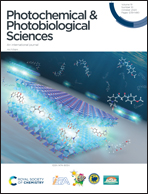In vitro protective effect of topical nanoemulgels containing Brazilian red propolis benzophenones against UV-induced skin damage
Abstract
The overexposure of the skin to ultraviolet (UV) radiation may lead to oxidative stress, resulting in severe damage. The prevention of skin injuries through the topical application of natural compounds rich in antioxidants, such as propolis extracts, has shown promising results. In Brazil, the “red propolis” extract has stood out due to its complex constitution, based mainly on polyprenylated benzophenones (BZP). However, although the use of red propolis extracts has been shown to be encouraging, their addition in topical formulations is limited by the low solubility of BZP. For this reason, this study aimed to develop topical nanoemulgels containing Brazilian red propolis (BRP) extract to increase the potential of topical application, and the evaluation of skin protection against UVA/UVB radiation damage by means of protein carbonylation, protein thiol content and TBARS assays. The nanoemulgels were obtained by adding gelling polymer to nanoemulsions that were previously prepared by spontaneous emulsification. In this sense, a nanoemulgel containing BRP extract-loaded nanoemulsions (H-NE) and a nanoemulgel containing BRP extract-loaded nanoemulsions with DOTAP (H-NE/DT) were prepared. The physicochemical characterization of nanoemulgels showed monodisperse populations of 200–300 nm. The H-NE zeta potential was −38 mV, while that of H-NE/DT was +36 mV. BZP content in the formulations was around 0.86 mg g−1. These parameters remained stable for 90 days under cold storage. H/NE and H-NE/DT presented a non-Newtonian pseudoplastic rheological behavior. Permeation/retention studies, through porcine ear skin, showed the highest BZP retention (18.11 μg cm−2 after 8 h) for H-NE/DT, which also demonstrated, in an in vitro study, the highest ability to protect skin against oxidative damage after UVA/UVB radiation exposure. The results concerning the antioxidant activity revealed that formulations containing the BRP n-hexane extract were the most promising in combating oxidative stress, probable due to the presence of polyprenylated BZP. Altogether, the outcomes of this study suggest that nanoemulgels have suitable characteristics for topical application, and may be an alternative for the prevention of oxidative skin damage caused by UVA/UVB radiation.



 Please wait while we load your content...
Please wait while we load your content...